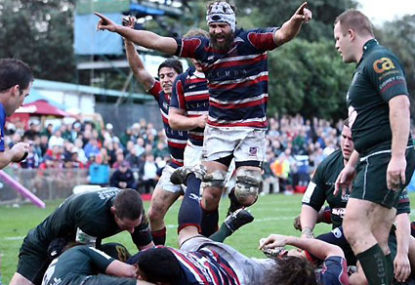A party from the British and Irish Lions yesterday visited Maitland and the grave of 1888 Lions captain Bob Seddon.
The Hunter region is one of rugby’s traditional territories, but who are Australia’s oldest rugby clubs, and why are they so few in number?
The Maitland Rugby Club, founded in 1877, claim they are the second oldest rugby club in Australia, following behind Sydney University (1863). Yet the Goulburn club’s website sets out on its history page that it was founded as a club in 1872.
The Parramatta club wears a badge with “1879” prominently displayed, and Randwick say their club began in 1882. The Balmain club, re-established in 2005, and Drummoyne (a merger of Balmain and Glebe in 1919), both lay claim to the Balmain club formed in 1873.
The founding clubs of the NSWRU in 1874 were: Wallaroo, Kings’ School, Newington College, Goulburn, Waratah, Balmain, North Shore, University and Camden College (in Redfern). Clubs were also in existence (per the “Town and Country Journal”) in St Leonards, Bathurst, Mudgee and Maitland.
At its 1880 annual meeting the NSWRU comprised: Albion, All Saints’ College, Carlton, Balmain, Bathurst, Burwood, Glen Head, Goulburn, Grammar School, King’s School, Maitland, Newcastle, Newtown, Newington College, New School, Oaklands, Old King’s, Parramatta, Queanbeyan, Redfern, St Leonards, Tamworth, Toxteth, University, Wallaroo, Wallsend, Waratah, and Woolhara.
All of the rugby clubs outside of the schools and university were membership-based clubs – you could join and play for any club you liked, so long as they would have you.
Each club had their own selection criteria for membership, and while some took on the name of a suburb, it didn’t automatically follow that just because you were a local that you would be accepted. Switching of talented players between clubs each year in Sydney was increasingly common by the mid 1890s.
In 1900 the NSWRU (via the Metropolitan RU) did away with all the Sydney clubs, apart from the University, and established a “district scheme” that divided the city and suburbs following electoral boundaries. This gave us the district clubs and three grades (Balmain, Norths, Wests, Easts, Souths, Newtown and Glebe, followed a few seasons later by boundary adjustment to create Manly, St. George and Sydney).
Dissatisfied that they could no longer play with friends but were being forced to play for the team where they lived and be separated across the different grades, in 1901 a number of newly formed (or perhaps re-formed) clubs established a rebel competition that remained unaffiliated to the NSWRU, and later became the City and Suburban Competition (‘Subbies’).
Determining the order in which clubs were first established really depends upon what criteria one chooses to apply, or not apply. Apart from the Sydney University club, and even putting aside the disruptions caused by wars, there is no club founded in the 19th century that has had a continuous existence ever since.
In most instances the connection is the town or suburb had an earlier rugby club, and that has been assigned by a new club as its own history. Perhaps that is an entirely reasonable approach, and it certainly helps to nurture and celebrate that local history of rugby, instead of letting it vanish or be ignored.
There is no doubt with rugby in Sydney the disconnect caused in 1900 by disbanding all the member-based clubs had its benefits to the growth of the code.
In comparison, such a restructuring never took place in London, where playing and supporting a club could mean any of the now long-famous names of Blackheath, Richmond, Wasps, Harlequins and Saracens, as well as London Scottish and London Welsh.
One can only wonder how much easier it would be to create and market a third tier of rugby in this professional era if alongside the University, Randwick and ‘Balmain’ were now over century-old Sydney clubs from the 1890s such as Wallaroo, Pirates, Wentworth, Redfern and Paddington.





























































































